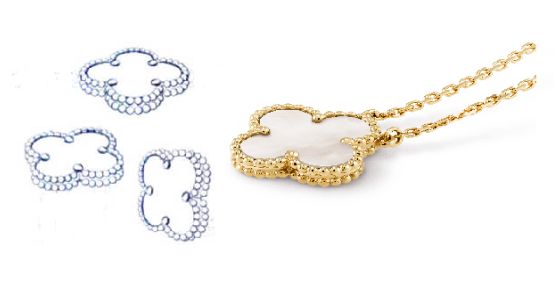- within Technology topic(s)
- with readers working within the Healthcare industries
Invalidation of 3D Trademark
Van Cleef & Arpels is the owner of the Chinese 3D trademark No. 15736970 (figure on the left) for its Alhambra product line (figure on the right) and the approved goods include jewelry. CNIPA decided on July 30, 2019 to invalidate this trademark in response to an invalidation request filed by Mr. Qingyu Bi. Van Cleef & Arpels appealed to Beijing Intellectual Property Court which upheld CNIPA's decision on May 27, 2020. Van Cleef & Arpels further appealed to Beijing High People's Court which again upheld Beijing IP Court's decision on Dec 16, 2020.

Beijing High People's Court held that according to Article 11.3 of the Trademark Law of 2013, other signs lacking distinctiveness shall not be registered as trademarks. "Other signs lacking distinctiveness" means that the signs when used as trademarks on designated goods do not have the function of distinguishing the source of goods in accordance with the common perceptions of the relevant public.
Article 9 of the judicial interpretation "Provisions of the Supreme People's Court on Several Issues Concerning the Trial of Administrative Cases for the Authorization and Confirmation of Trademarks" stipulates that where only the shape of the product itself or a part of its shape is used as a 3D sign to apply for a trademark and it is generally difficult for the relevant public to recognize it as an indication of the source of goods, the 3D sign does not have the distinctiveness of being a trademark. The shape being the original creation of or used earliest by the applicant does not necessarily cause it to have distinctiveness as a trademark. This article further stipulates that if after long-term or extensive use of the mark, the relevant public can identify the source of the goods through the mark, then the mark can be determined to have distinctiveness.
Beijing High People's Court held that a large number of vendors in this field have used "four-leaf clover" on jewelry, which downplays the function of the disputed trademark to indicate the source of goods. The court found the evidence produced by Van Cleef & Arpels is not sufficient to prove that the disputed trademark has acquired distinctiveness through use.
Victory in Unfair Competition Case
Up to this point it seemed that Van Cleef & Arpels is not able to protect the four-leaf clover design because it has lost this 3D trademark. However, according to a news report by Zhichanli in February 2021, Van Cleef & Arpels recently won a related infringement case and was awarded RMB 1.5 million (about USD230,770) for damages and reasonable expenses. In 2019, Van Cleef & Arpels sued Shanghai Aijing Jewelry and Beijing Hexinlicheng Jewelry in Beijing Chaoyang District People's Court, alleging that the defendants sold jewelry bearing the unique decoration of Van Cleef & Arpels' well-known goods which caused confusion among consumers and constituted unfair competition.
Article 2.1 of the "Interpretation of the Supreme People's Court on Several Issues Concerning the Application of Law in the Trial of Unfair Competition Civil Cases" stipulates that the name, packaging, and decoration of commodities with distinctive features that distinguish the source of commodities shall be recognized as the unique name, packaging and decoration prescribed in Article 5 the Anti-Unfair Competition Law.
The reasoning of Beijing Chaoyang District People's Court can be summarized as follows.
· Generally speaking, "decoration" is not an item itself or a component part of an item. It plays a role in decoration and beautification of an item, and can be separated from the practical part. But for jewelry products, it is impossible to separate the part that conveys beauty from the jewelry itself and hence it can be considered that the whole jewelry product constitutes a product decoration in terms of shape and structure.
· For jewelry products, the four-leaf clover shape is obviously not a universal shape, nor is it a shape that only reflects the inherent characteristics of the product's quality, raw materials, or functions. Therefore, the four-leaf clover shape and other elements meet the condition for constituting product decoration as protected by the Anti-Unfair Competition Law. The product decoration claimed by Van Cleef & Arpels includes the basic four-leaf clover and other elements such as edging and the strong contrast between the main plane and the frame. The combination of elements is more distinctive than the simple four-leaf shape.
· Before the extensive use of the decoration by Van Cleef & Arpels, there was no evidence to prove that jewelry of this type has become a universal style in the industry. The use by other vendors in the industry after the use by Van Cleef & Arpels cannot directly lead to the loss of its distinctiveness.
·A large amount of evidence provided by Van Cleef & Arpels has shown that, for the relevant public, when they see the jewelry bearing the decoration of Van Cleef & Arpels, the Van Cleef & Arpels brand is often identified. It shows that the products bearing the decoration of Van Cleef & Arpels' has the function of identifying the source of goods. According to the provisions of the Anti-Unfair Competition Law, the court determines that the decoration of the jewelry products used by Van Cleef & Arpels constitutes a product decoration having certain influence under the protection of the Anti-Unfair Competition Law.
Accordingly, the court found the two defendants violated the Anti-Unfair Competition Law and issued injunction and awarded a total of RMB 1.5 million (about USD230,770) to Van Cleef & Arpels.
The judgment provides clear guidance to the jewelry industry or fashion industry by providing a new option for enforcing rights, in addition to the commonly perceived trademarks, designs and copyrights. The successful enforcement under Anti-Unfair Competition Law depends on various factors, such as whether the decoration can be regarded as product decoration under Anti-Unfair Competition Law, whether the decoration achieved certain influence and whether the alleged infringing products lead to confusion.
Another great example of successful use of Anti-Unfair Competition Law is Jaguar Land Rover vs. Jiangling Motors. Jaguar Land Rover successfully proved the Evoque design is a product design having certain influence. The court found the Landwind X7 of Jiangling Motors used the product design of Evoque which led to confusion and constitute unfair competition.
The content of this article is intended to provide a general guide to the subject matter. Specialist advice should be sought about your specific circumstances.
[View Source]

